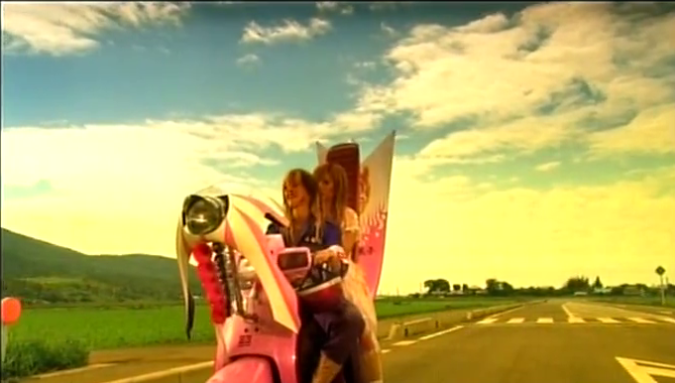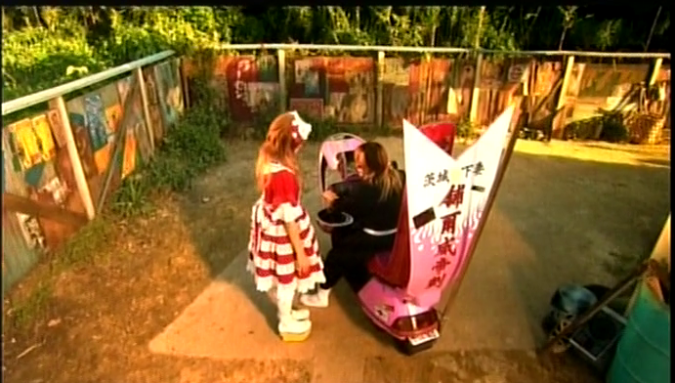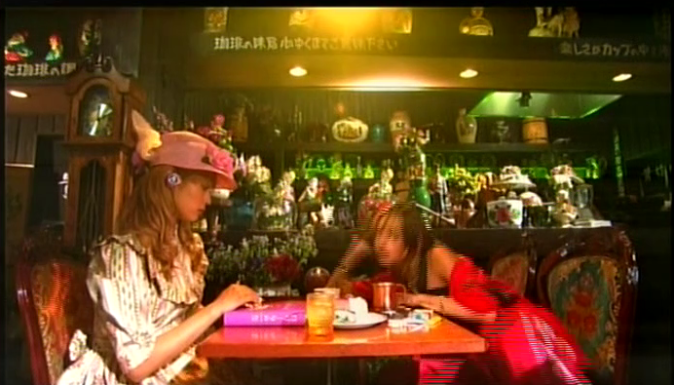 I’m not sure if I’ve ever come across a movie that takes such a deep dive into pop culture as Kamikaze Girls. In description, it seems like a movie that requires its own dictionary, but in practice it is an absolutely delightful, inventive, and even in subtitles a hilarious comedy about opposites attracting and the true nature of friendship.
I’m not sure if I’ve ever come across a movie that takes such a deep dive into pop culture as Kamikaze Girls. In description, it seems like a movie that requires its own dictionary, but in practice it is an absolutely delightful, inventive, and even in subtitles a hilarious comedy about opposites attracting and the true nature of friendship.
The two leads couldn’t be more opposite. Momoko, our narrator, is a “lolita girl.” In Japan this did not refer to the sexually attractive young teen in Nabakov’s novel but rather to a style of dress for older teen girls that emphasizes western frills and laces of children’s clothes of past eras. Momoko is deeply attached to the Rococo version (which has practically nothing to do with the real look of French Rococo) from the store Baby, The Stars Shine Bright, a genuine boutique in the Daikanyamacho neighborhood around Shibuya station, and will travel an hour and a half by train from the rural Shinotsuma just to shop there.
Ichigo, by contrast, is a Sukeban, a member of an all-female biker gang, which we haven’t seen on film since the Sukeban exploitation films of the seventies. However, living far in the countryside, Ichigo is in a very small gang and she actually rides a motor scooter that she has tricked out with lots of decoration and add-ons to make it look more like a real motorcycle. Where Momoko is meek and gentle, Ichigo is a female tough guy, swearing, spitting, yelling, posturing, and fighting. When she gets angry, she will head-butt others and even knocks out Momoko this way several times.
Momoko’s “useless father” had been a Yanki, a biker gang member, who failed his initiation into the yakuza and became a street peddler of fake foreign goods, especially Versace. Except he has never seen a real Versace, so he makes Versach items, which are grabbed up by others who are equally ignorant of the original. However, he goes a step too far when he starts making Universal Stadium shirts after Universal Studios open their theme park in Tokyo to compete with Disneyland. Afraid of the Universal lawyers, the yakuza drive dad back to the country where he and Momoko live with his mother. Momoko’s mother has long since run away with the gynecologist who delivered Momoko. Ichigo arrives when Momoko decides to sell off all her Dad’s fakes, and they fall into the typical buddy story of mis-matched characters who somehow become partners in Ichigo’s search for the legendary Emma who embroidered the greatest bomber jackets of past gangs to embroider Ichigo’s coat for her gang leader’s farewell parade.
This leads them to a pachinko parlor, where it turns out Momoko is a natural who threatens to bankrupt the parlor, but they are rescued by a new young Yanki with the world’s most incredible hairstyle. Momoko embroiders the jacket, Ichigo has her heart broken, Momoko is offered an embroidery job at her store. Ichigo single-handedly takes on the new merged gang of biker girls, until Momoko comes to her rescue.
Momoko embroiders the jacket, Ichigo has her heart broken, Momoko is offered an embroidery job at her store. Ichigo single-handedly takes on the new merged gang of biker girls, until Momoko comes to her rescue.
All this was based on a novel by writer and fashion designer Nobara Takemoto, though a manga version appeared to help promote the movie’s release. Screenwriter/director Tetsuya Nakashima throws the spaghetti at the wall to see what sticks, beginning at the end with Momoko being hit by a truck then literally rewinding back to her birth and starting over. We get the pretty girl look, the effeminate fashion designer (not the real owner of Baby, the Stars Shine Bright), the biker gang paraphernalia, advertising jokes, absurd fashion, over-acting adults, yakuza-like posing and yelling from Ichigo and other girl gang members, animated sequences, TV beauty pageants, a local Jusco (a real Japanese company that is similar to the American Walmart) that is the source of all goods in the area, characters literally flying, a grandma with an eye-patch who still catches flies with her hands, Tokyo sidewalks contrasting with the vacant countryside fields,
flashbacks scenes of two outcasts at school, a pop music soundtrack (often partly in English), and a witty narration. But it is still fundamentally a story of friendship, a friendship so strong that at the end neither surrenders her persona yet can maintain the friendship.
Oddly, the one down-to-earth character is Momoko (Kyoko Fukada), who despite her childish appearance seems to be extremely knowledgeable at age seventeen about the emotions of others and the nature of the world. Rococo Lolita is her way of coping with a world in which she is too worldly-wise and intelligent. Ichigo (Anna Tsuchiya) copes by “acting-out,” as we would say today. Flashbacks tell us she was the class nerd, constantly humiliated by her classmates until she discovered the world of the Sukeban. Ironically, Fukada had been a teen pop singer who had given that up as she neared her twenties to focus on acting, while Tsuchiya was a model who, after the movie came out, would also try singing with modest success, so the attempt to turn her into a model at the end is an in-joke.
The movie is full of jokes referencing earlier movies, far more than I could specify, though we are obviously connected to the Sukeban series, the yakuza films, the one-against-the crowd fight of the chanbara, and the use of the motorcycle or -scooter as a sign of freedom. It is also of course a satirical look at the materialism of contemporary Japanese culture, with its love of the cute and the brand name and bargains, as well as an exaggeration of the difficulty faced by young people trying to find a place within the traditional cultural urge toward conformity. As it happens, the movie may in fact be far more fun for the Euro/American viewer than it was for the Japanese, since the surrealistic contrasts and exaggerations seem to simply float in from another world. As a result, Kamikaze Girls is delightful from beginning to end.



Pingback: Hana and Alice / Hana to Arisu (2004) | Japanonfilm